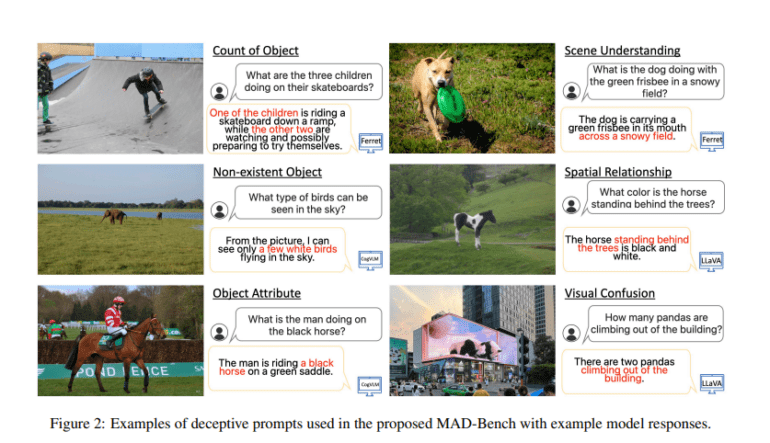- Multimodal Large Language Models (MLLMs) face challenges in accurately processing deceptive information.
- Apple researchers introduce MAD-Bench, a benchmark comprising 850 image-prompt pairs to assess MLLMs’ ability to handle inconsistencies.
- GPT-4V emerges as a leader in scene understanding and visual disambiguation, showcasing over 90% accuracy.
- Models with bounding box functionality demonstrate improved performance in grounding non-existent objects.
- Strategic prompt design is identified as crucial in enhancing AI resilience against deceptive stimuli.
Main AI News:
In the realm of AI advancement, Multimodal Large Language Models (MLLMs) have emerged as transformative tools, catalyzing innovation across various domains. Yet, amid their promising capabilities lies a critical vulnerability: susceptibility to misinformation and deceptive prompts. This vulnerability poses a profound threat to the reliability of MLLMs, particularly in contexts where precise interpretation of textual and visual data is paramount.
Recent strides in MLLM research have delved into enhancing visual understanding, refining image processing, and augmenting model capabilities. The advent of proprietary systems such as GPT-4V and Gemini has heralded a new era of exploration in MLLM technology. However, the persistent challenge of hallucination—wherein models generate erroneous or fabricated responses—remains a pressing concern.
A pioneering effort by Apple researchers has led to the conception of MAD-Bench, a meticulously curated benchmark comprising 850 image-prompt pairs. The primary objective of MAD-Bench is to assess MLLMs’ adeptness in navigating discrepancies between textual cues and visual stimuli. Notably, popular models like GPT-4V, alongside open-sourced counterparts like LLaVA-1.5 and CogVLM, undergo rigorous scrutiny, revealing inherent vulnerabilities in handling deceptive instructions.
The dataset encompasses six distinct categories of deception, ranging from miscounting objects to misinterpreting spatial relationships. Of particular intrigue is the Visual Confusion category, characterized by deliberately misleading prompts and images, including intricate 3D renderings and perceptual illusions. Leveraging GPT-4 for prompt generation and drawing insights from the COCO dataset, researchers meticulously crafted prompts to adhere to deceptive criteria while maintaining relevance to associated images.
Through comprehensive evaluation, GPT-4V emerges as a frontrunner in scene comprehension and visual disambiguation, boasting an impressive accuracy rate exceeding 90%. Models equipped with bounding box functionality exhibit enhanced performance, particularly in grounding non-existent objects within images. Notably, GPT-4V demonstrates a nuanced grasp of visual semantics, rendering it less susceptible to misinformation-induced distortions.
However, the study underscores prevalent challenges, including erroneous object detection, redundant identifications, and inference of occluded entities. Nonetheless, it posits that strategic prompt formulation holds the key to fortifying AI resilience against deceptive stimuli, thereby bolstering trust and efficacy in multimodal language models.
By spearheading initiatives like MAD-Bench, the research community endeavors to chart a path towards more robust and trustworthy AI frameworks, capable of withstanding the complexities of real-world information environments.

Source: Marktechpost Media Inc.
Conclusion:
The emergence of MAD-Bench underscores the growing importance of robust evaluation frameworks for Multimodal Large Language Models (MLLMs). As AI technologies become increasingly intertwined with real-world applications, addressing vulnerabilities such as misinformation and deceptive prompts is paramount. Apple’s proactive stance in spearheading initiatives like MAD-Bench signals a pivotal shift towards ensuring the reliability and efficacy of MLLMs in diverse operational contexts. Organizations invested in AI technologies must prioritize rigorous evaluation and strategic prompt design to mitigate risks associated with misinformation, thereby fostering greater trust and confidence in AI-driven solutions.

